Do you have a question about the A.O. Smith CYCLONE Xi BTH 500A and is the answer not in the manual?
Precise adherence to instructions is vital to prevent fire or explosion, averting property damage, injury, or death.
Immediate actions for gas detection: do not use electricity/phones, call supplier from neighbor's phone.
Red text indicates critical safety information that must be read and understood before installation and use.
Illustrates critical installation clearances, connection points, and overall unit dimensions.
Provides water recovery rates (GPH/LPH) across a range of temperature rises for different models.
Details the system for adjusting and monitoring water temperature, including safety considerations.
Emphasizes severe burn risk from hot water, especially for vulnerable individuals; advises on safe usage.
Visual guide to essential installation points, connections, and clearances for rapid setup.
Illustrations showing requirements for sidewall and rooftop venting, crucial for safe exhaust and air intake.
Procedure to set desired water temperature and understand scald risk factors related to usage patterns.
Explains the high limit switch's safety role in preventing overheating by shutting off the burner.
Specifies water pressure and temperature needs for effective dishwashing sanitation.
Guidance on electrical hookup and code compliance for installing a circulating pump.
Defines the essential skills equivalent to a licensed tradesman for installation and service.
Information on the use of insulation blankets, including restrictions and potential risks if improperly applied.
Critical warnings on safe placement, avoiding physical damage, noise, flammable materials, freezing, and leaks.
Instructions ensuring proper condensate drainage to prevent unit malfunction and operational hazards.
Diagram and details for maintaining required clearances from combustible materials and for service access.
Advice on water softening or treatment to protect equipment from hard water deposits.
Crucial information on providing adequate combustion and ventilation air to prevent hazardous conditions.
Alerts regarding corrosive chemicals that can damage the vent system and pose asphyxiation risks.
Mandatory requirements for CO detectors, signage, and inspection in Massachusetts installations.
Manufacturer guidelines for installing provided or external venting systems for gas appliances.
Critical warning to follow venting instructions to avoid combustion issues, fire, or asphyxiation.
Diagrams detailing minimum clearances for direct vent terminals in US installations, covering various scenarios.
Diagrams detailing minimum clearances for direct vent terminals in Canadian installations, covering various scenarios.
Warning to maintain maximum practical distance between air intake and exhaust to prevent recirculation.
Diagrams showing minimum clearances for horizontal vent terminals in US installations.
Diagrams showing minimum clearances for horizontal vent terminals in Canadian installations.
Advice to maximize distance between terminals to prevent air intake contamination in windy/cold conditions.
Instructions for determining and installing vent pipe termination points, avoiding noise and vibration.
Specific instructions for direct venting, including removing guards and connecting intake pipes.
Notes and specifications for installing direct vent terminals on sidewalls.
Step-by-step guide for installing vent terminals through sidewalls, including cutting openings.
Specifications for terminating vent pipes through roofs, ensuring proper support and sealing.
Critical warning to keep venting separate from other systems to prevent operational hazards, fire, or explosion.
Table and guidelines on maximum vent pipe lengths and the number of elbows allowed for intake and exhaust.
Information on approved PVC, CPVC, ABS pipe materials and the required downward slope for condensate drainage.
Detailed steps for preparing PVC, ABS, or CPVC pipes and selecting appropriate primers and cements.
Explanation of the four pressure switches (Blower Prover, Blocked Outlet, Blocked Inlet, Low Gas) and their safety roles.
Description of the ON/OFF switch's function for powering the unit on and off.
Explanation of the hot surface igniter's role in lighting the main burner safely and efficiently.
Guidelines for gas piping installation, including sizing based on capacity tables and pressure drop.
Critical warnings regarding maximum gas supply pressures and potential hazards of overpressure or underpressure.
Instructions for connecting gas pipes, including the use of dirt legs and performing essential leak tests.
Details on the temperature and pressure relief valve, its function, and critical warnings about its use and maintenance.
References to installation diagrams for proper water line connections.
Explanation of potential issues with closed water systems, thermal expansion, and required precautions.
Instructions and safety warnings for properly purging gas lines to remove air before operation.
Guidelines for using the unit for potable water and space heating, including chemical restrictions.
Instructions for wiring the heater, emphasizing clean electricity, polarity sensitivity, and code compliance.
Detailed wiring diagram showing connections for the BTH 300 model, including all components and terminals.
Detailed wiring diagram illustrating connections for the BTH 400 and 500 models, covering all components.
Step-by-step description of the water heater's operating sequence from startup to shutdown.
Introduction to the electronic control interface, buttons, and display screens for operation.
Explanation of the graphical icons and text descriptions indicating the heater's current operational status.
Procedure for changing the water temperature setpoint and understanding related temperature readings displayed.
Instructions for customizing display units (Fahrenheit/Celsius), backlight, and contrast on the LCD screen.
Explanation of the two types of conditions (Warnings and Faults) detected by the control system and their implications.
Description of fault conditions that halt heating, requiring correction, and accessing advanced diagnostics for resolution.
How to access and review a log of past faults and warnings, including diagnostic details for each event.
Accessing detailed operational data and status of specific conditions through the control interface menus.
Specifies the essential skills and test equipment necessary for performing initial startup procedures safely.
Essential steps for filling the heater with water, purging air, and preparing it for initial operation.
Detailed steps for adjusting gas pressure and checking operation during the initial startup phase.
Crucial safety warnings and immediate actions for gas leaks, hot surface igniters, and general operation procedures.
Numbered steps for safely operating the water heater, including thermostat setting and gas control knob usage.
Information on heater certification for altitudes up to 10,000 feet and requirements for higher installations.
Warnings about hydrogen gas production in idle systems and precautions to take before using hot water.
Introduction to maintenance tasks including flushing, cleaning, inspection, and component checks.
A table outlining the recommended maintenance schedule for various components of the water heater.
Steps for flushing the water heater to remove sediment and debris from the tank.
Instructions for draining the heater, essential for shutdown, freezing prevention, or maintenance.
Methods for removing sediment and lime scale from the tank, including product recommendations and scheduling.
Description of the powered anode system designed to ensure a long, trouble-free operating life.
Information on the location and function of the drain valve and access panels.
Procedure for checking the relief valve's operation and addressing potential issues like thermal expansion or faulty valves.
Guidelines for inspecting and cleaning the vent system components to ensure proper operation and safety.
Diagram showing installation for a single heater with a vertical storage tank, including circulation options.
Diagram illustrating installation for a single heater with a horizontal storage tank, including circulation options.
Diagram for a two-temperature, one-heater system with high temperature capabilities and recirculation options.
Diagram for a two-heater system with high temperature output, with or without recirculation.
Diagram for a three-heater system configuration, including pre-heaters and a booster.
Diagram for a system with one pre-heater and one booster heater, detailing connections and temperature settings.
Diagram illustrating a two-temperature system with recirculation of a sanitizing loop, including dishwasher connections.
General principles for installing multiple water heaters to ensure balanced flow and storage potential.
Diagrams showing minimum space requirements and manifold connections for two, three, and four unit installations.
Guidance on diagnosing and resolving issues related to burner operation, including no hot water or improper firing.
Information on common sounds and potential water leakage issues, including causes and checks.
A checklist of common troubleshooting steps for various operational issues, including vent, gas supply, and polarity checks.
Steps to diagnose why the motor is not running, checking voltage, polarity, and VFD status.
Troubleshooting steps for when the burner lights but fails to sustain ignition, checking gas pressure and igniter.
Guidance for issues where the burner lights briefly then shuts down, focusing on gas pressure and polarity.
Information on causes of noisy burner operation and methods to mitigate it, including air/gas ratio tuning.
Troubleshooting steps for when the gas fails to shut off, focusing on defective valves or thermostats.
Instructions on how to order replacement parts from A.O. Smith, including necessary information.
Details on the warranty coverage for the tank and other parts, including conditions, exceptions, and limitations.
Information on how to initiate a warranty claim and the responsibilities of the owner and warrantor.
Precise adherence to instructions is vital to prevent fire or explosion, averting property damage, injury, or death.
Immediate actions for gas detection: do not use electricity/phones, call supplier from neighbor's phone.
Red text indicates critical safety information that must be read and understood before installation and use.
Illustrates critical installation clearances, connection points, and overall unit dimensions.
Provides water recovery rates (GPH/LPH) across a range of temperature rises for different models.
Details the system for adjusting and monitoring water temperature, including safety considerations.
Emphasizes severe burn risk from hot water, especially for vulnerable individuals; advises on safe usage.
Visual guide to essential installation points, connections, and clearances for rapid setup.
Illustrations showing requirements for sidewall and rooftop venting, crucial for safe exhaust and air intake.
Procedure to set desired water temperature and understand scald risk factors related to usage patterns.
Explains the high limit switch's safety role in preventing overheating by shutting off the burner.
Specifies water pressure and temperature needs for effective dishwashing sanitation.
Guidance on electrical hookup and code compliance for installing a circulating pump.
Defines the essential skills equivalent to a licensed tradesman for installation and service.
Information on the use of insulation blankets, including restrictions and potential risks if improperly applied.
Critical warnings on safe placement, avoiding physical damage, noise, flammable materials, freezing, and leaks.
Instructions ensuring proper condensate drainage to prevent unit malfunction and operational hazards.
Diagram and details for maintaining required clearances from combustible materials and for service access.
Advice on water softening or treatment to protect equipment from hard water deposits.
Crucial information on providing adequate combustion and ventilation air to prevent hazardous conditions.
Alerts regarding corrosive chemicals that can damage the vent system and pose asphyxiation risks.
Mandatory requirements for CO detectors, signage, and inspection in Massachusetts installations.
Manufacturer guidelines for installing provided or external venting systems for gas appliances.
Critical warning to follow venting instructions to avoid combustion issues, fire, or asphyxiation.
Diagrams detailing minimum clearances for direct vent terminals in US installations, covering various scenarios.
Diagrams detailing minimum clearances for direct vent terminals in Canadian installations, covering various scenarios.
Warning to maintain maximum practical distance between air intake and exhaust to prevent recirculation.
Diagrams showing minimum clearances for horizontal vent terminals in US installations.
Diagrams showing minimum clearances for horizontal vent terminals in Canadian installations.
Advice to maximize distance between terminals to prevent air intake contamination in windy/cold conditions.
Instructions for determining and installing vent pipe termination points, avoiding noise and vibration.
Specific instructions for direct venting, including removing guards and connecting intake pipes.
Notes and specifications for installing direct vent terminals on sidewalls.
Step-by-step guide for installing vent terminals through sidewalls, including cutting openings.
Specifications for terminating vent pipes through roofs, ensuring proper support and sealing.
Critical warning to keep venting separate from other systems to prevent operational hazards, fire, or explosion.
Table and guidelines on maximum vent pipe lengths and the number of elbows allowed for intake and exhaust.
Information on approved PVC, CPVC, ABS pipe materials and the required downward slope for condensate drainage.
Detailed steps for preparing PVC, ABS, or CPVC pipes and selecting appropriate primers and cements.
Explanation of the four pressure switches (Blower Prover, Blocked Outlet, Blocked Inlet, Low Gas) and their safety roles.
Description of the ON/OFF switch's function for powering the unit on and off.
Explanation of the hot surface igniter's role in lighting the main burner safely and efficiently.
Guidelines for gas piping installation, including sizing based on capacity tables and pressure drop.
Critical warnings regarding maximum gas supply pressures and potential hazards of overpressure or underpressure.
Instructions for connecting gas pipes, including the use of dirt legs and performing essential leak tests.
Details on the temperature and pressure relief valve, its function, and critical warnings about its use and maintenance.
References to installation diagrams for proper water line connections.
Explanation of potential issues with closed water systems, thermal expansion, and required precautions.
Instructions and safety warnings for properly purging gas lines to remove air before operation.
Guidelines for using the unit for potable water and space heating, including chemical restrictions.
Instructions for wiring the heater, emphasizing clean electricity, polarity sensitivity, and code compliance.
Detailed wiring diagram showing connections for the BTH 300 model, including all components and terminals.
Detailed wiring diagram illustrating connections for the BTH 400 and 500 models, covering all components.
Step-by-step description of the water heater's operating sequence from startup to shutdown.
Introduction to the electronic control interface, buttons, and display screens for operation.
Explanation of the graphical icons and text descriptions indicating the heater's current operational status.
Procedure for changing the water temperature setpoint and understanding related temperature readings displayed.
Instructions for customizing display units (Fahrenheit/Celsius), backlight, and contrast on the LCD screen.
Explanation of the two types of conditions (Warnings and Faults) detected by the control system and their implications.
Description of fault conditions that halt heating, requiring correction, and accessing advanced diagnostics for resolution.
How to access and review a log of past faults and warnings, including diagnostic details for each event.
Accessing detailed operational data and status of specific conditions through the control interface menus.
Specifies the essential skills and test equipment necessary for performing initial startup procedures safely.
Essential steps for filling the heater with water, purging air, and preparing it for initial operation.
Detailed steps for adjusting gas pressure and checking operation during the initial startup phase.
Crucial safety warnings and immediate actions for gas leaks, hot surface igniters, and general operation procedures.
Numbered steps for safely operating the water heater, including thermostat setting and gas control knob usage.
Information on heater certification for altitudes up to 10,000 feet and requirements for higher installations.
Warnings about hydrogen gas production in idle systems and precautions to take before using hot water.
Introduction to maintenance tasks including flushing, cleaning, inspection, and component checks.
A table outlining the recommended maintenance schedule for various components of the water heater.
Steps for flushing the water heater to remove sediment and debris from the tank.
Instructions for draining the heater, essential for shutdown, freezing prevention, or maintenance.
Methods for removing sediment and lime scale from the tank, including product recommendations and scheduling.
Description of the powered anode system designed to ensure a long, trouble-free operating life.
Information on the location and function of the drain valve and access panels.
Procedure for checking the relief valve's operation and addressing potential issues like thermal expansion or faulty valves.
Guidelines for inspecting and cleaning the vent system components to ensure proper operation and safety.
Diagram showing installation for a single heater with a vertical storage tank, including circulation options.
Diagram illustrating installation for a single heater with a horizontal storage tank, including circulation options.
Diagram for a two-temperature, one-heater system with high temperature capabilities and recirculation options.
Diagram for a two-heater system with high temperature output, with or without recirculation.
Diagram for a three-heater system configuration, including pre-heaters and a booster.
Diagram for a system with one pre-heater and one booster heater, detailing connections and temperature settings.
Diagram illustrating a two-temperature system with recirculation of a sanitizing loop, including dishwasher connections.
General principles for installing multiple water heaters to ensure balanced flow and storage potential.
Diagrams showing minimum space requirements and manifold connections for two, three, and four unit installations.
Guidance on diagnosing and resolving issues related to burner operation, including no hot water or improper firing.
Information on common sounds and potential water leakage issues, including causes and checks.
A checklist of common troubleshooting steps for various operational issues, including vent, gas supply, and polarity checks.
Steps to diagnose why the motor is not running, checking voltage, polarity, and VFD status.
Troubleshooting steps for when the burner lights but fails to sustain ignition, checking gas pressure and igniter.
Guidance for issues where the burner lights briefly then shuts down, focusing on gas pressure and polarity.
Information on causes of noisy burner operation and methods to mitigate it, including air/gas ratio tuning.
Troubleshooting steps for when the gas fails to shut off, focusing on defective valves or thermostats.
Instructions on how to order replacement parts from A.O. Smith, including necessary information.
Details on the warranty coverage for the tank and other parts, including conditions, exceptions, and limitations.
Information on how to initiate a warranty claim and the responsibilities of the owner and warrantor.
| Category | Water Heater |
|---|---|
| Brand | A.O. Smith |
| Model | CYCLONE Xi BTH 500A |
| Gas Type | Natural Gas |
| Fuel Type | Natural Gas |

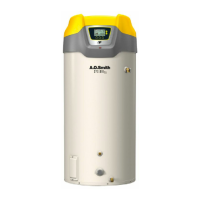
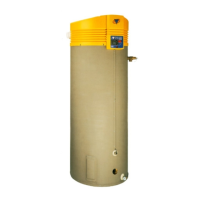
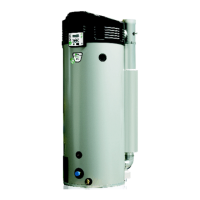
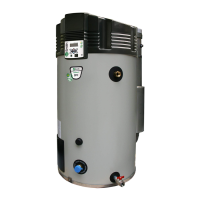
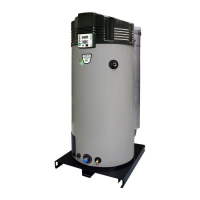


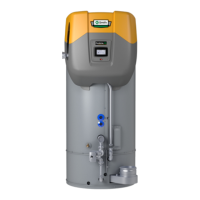
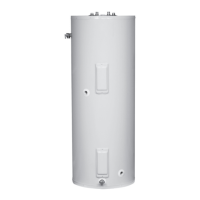

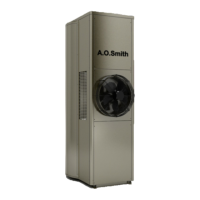
